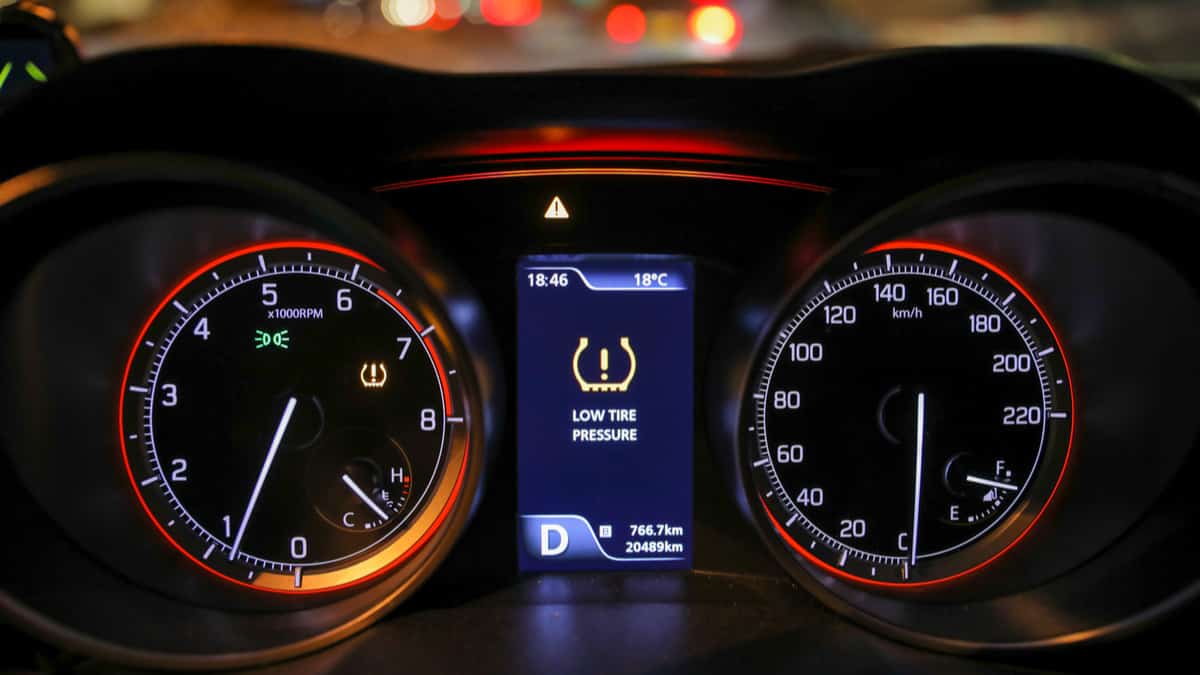The TPMS light lets you know when the tire pressure is low, so you can remain safe on the road. Yet, there are times when the sensors or system malfunction, causing the low tire pressure light to come on when the tires are fine. What causes this problem and what can be done about it?
In this guide, we look at each of these reasons in-depth. We also examine the differences between the varying types of TPMS systems and show you how to fix the faulty light. At the end of our guide, we help you decide if it’s okay to drive with the TPMS light on.
Causes of Low Tire Pressure Light is On with Correct Tire Pressure
If your low tire pressure light is on even if the tire pressure is fine, you may need to reset the TPMS. It can also be due to a faulty TPMS sensor. However, the sensor battery might also be dead or the TPMS receiver could be damaged. If you have an indirect TPMS system, the problem could be due to the loss of traction.
Here is some more detailed information on possible reasons why the low tire pressure light is on but the tire pressure is good.
1. Faulty or Unprogrammed Tire Pressure Sensor
If you corrected the tire pressure, but the TPMS light is still on, you may need to reset the TPMS system with either a scanner or check the procedure for your specific car model. Sometimes the tire pressure sensors lose the programmed data and you may need to use an OBD2 scanner or TPMS Reset tool to reprogram the TPMS sensor if everything else seems fine.
READ MORE: How to Reset Tire Pressure Light (TPMS) – By Car Model
The TPMS sensor can also be easily damaged, which causes the light to remain on. The problem with a faulty sensor is that it isn’t monitoring the tire pressures, putting you at risk.
The sensor can be damaged due to debris or contaminants. It can also be damaged during the mounting and dismounting of the tires, as special care is needed to ensure the sensors are protected.
2. Dead Battery in Sensor
Direct monitoring TPMS sensors need batteries to operate correctly. These batteries are made to last a long time, but they can still fail. On average, the batteries might fail every five to ten years.
If the battery dies, there can’t be any feedback through the system. This breakdown in communication causes the light to come on.
RELATED: Tire Pressure Sensor Fault (What It Means & How to Fix It)
3. Defective TPMS Receiver
This issue isn’t as common as the other two, but it can happen. The receiver of the TPMS can fail, leading to a loss of pressure data from the tires.
There’s no rhyme or reason as to why this happens occasionally, other than it’s electronic equipment that can be fallible. It won’t matter what pressure is in each tire, the TPMS light will come on.
4. Traction Loss
If your car uses an indirect TPMS configuration, any loss of traction could cause the light to come on. These systems use the wheel speed sensor information to tell when there’s a problem with the tire pressures.
However, when traction is lost, the sensors could determine the cause is low tire pressure, even when it’s not. This problem can lead to some confusion, especially when the light comes on and off periodically.
RELATED: 3 Signs of a Bad Tire Pressure Sensor (& Replacement Cost)
Understanding Direct vs. Indirect TPMS
1. Direct
The direct TPMS is used in most cars on the road today. With this design, all four wheels have a sensor that feeds information back to the computer. If the tire pressure gets low, a signal is sent and the alert comes on the dashboard.
Because of where the sensors are located, there can be damage to them when driving on harsh road conditions, such as dirt driveways or during service. They also go bad simply because of old age, requiring replacement over time.
2. Indirect
Some manufacturers prefer the indirect system, which doesn’t use a sensor on each wheel. Instead, the TPMS runs from the sensors on the anti-lock brakes. These sensors determine when the rotation speed is slow, indicating that tire pressure might be low.
The indirect TPMS is considered more durable than the normal system because it doesn’t fail as often. However, you aren’t going to know if multiple tires are running low since there aren’t separate sensors.
Up until now, it’s only been some Asian and European automakers that have chosen this TPMS configuration. However, other automakers are discussing switching over, making it more of a standard option across the board.
How to Fix TPMS Light
1. Fill Tire with Air
The most obvious solution is to fill the low tire with the right amount of air. When the light comes on, you should always start by checking the tire pressures.
You can compare the reading with the recommended air pressure by looking at the driver’s side door jamb. If the light remains on despite the pressures being right, you have to move on to our other tips.
READ MORE: How to Find the Correct Tire Pressure For Your Car (4 Steps)
2. Repair Fault
The repair you continue with depends on what is causing the fault. If you don’t have the equipment to figure out what’s wrong, you should visit a qualified mechanic.
If the car needs a simple TPMS sensor, you might spend between $75 and $250 for the part and labor. In most cases, a dead battery will also require a new sensor replacement. If the receiver needs to be replaced, the price is going to be slightly more.
If you have the equipment to work on these sensors and receivers, you could perform the repair yourself. By doing so, you cut out the expense of the labor charge.
3. Reset Light
If the light has come on because there was a problem after wheel rotation or another service, you may just need to reset the light. Most manufacturers have a simple way to reset the warning light. You can find it in your owner’s manual.
There might be a reset button in your car’s glove compartment or in the menu of your car settings. However, you need to know how long to press the button and what steps are necessary to get the job done.
Can I Drive with the TPMS Light On?
You should never ignore the warning given by the TPMS light. If you notice it on the dashboard, you want to stop as soon as it’s safe to ensure that there’s enough air pressure in the tires. If the tires aren’t inflated properly, failure is imminent. The tires could overheat and blow out, leading to a dangerous situation. You also lose control as the tire pressures continue to drop. At the least, the underinflation is causing the tires to wear unevenly, leading to the need for replacement more frequently.
Additionally, when the TPMS light is on with the tires perfectly inflated, you aren’t going to know when there is a problem. If a sensor is bad and you ignore it, one of the tires could become underinflated and you have no way of knowing.
As the tires get lower, you start to deal with:
- Delayed driving response
- Additional wear to the tires
- Overheating tires
- Reduced traction
- Bumpier ride
- Less on-road control
For the cost of adding air or repairing the fault, it’s not worth taking the risk. You will spend a fraction to get the repair than what you might be liable for in the instance of a major accident. Plus, a significant collision could lead to a complete change in lifestyle if there are injuries. Is any of this worth ignoring the helpful TPMS light?
Categories: Tires, Warning Lights

















